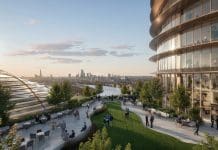The British Property Federation (BPF) has launched its Great Places campaign, a year-long programme of initiatives that will not only spread best practice amongst the real estate industry, but will actively encourage members of the industry to commit to good place shaping in all future work
The Great Places campaign will aim to showcase the real estate industry’s collective role and social impact across the UK to its customers and government, as well as the communities it invests in for the long term. It will comprise of a series of roundtables, larger-scale industry events and educational materials, as well as articulating policy barriers to the creation of successful places.
At a time when government is focused on the quality of buildings and construction, Great Places will examine the components and changing dynamics of successful places, and provide a platform for real estate businesses to share knowledge, working in partnership with the wider industry and the public sector.
An inaugural half-day conference will be held today (31 October), hosted by Savills in central London, where industry leaders from across the public and private sectors will come together to present practical examples of creating and sustaining great places.
The conference coincides with the publication of A Guide to Commissioning Public Art, a toolkit by the BPF and Contemporary Art Society, which aims to provide developers with a framework for commissioning in situ art. The guide highlights how art contributes to a development’s unique sense of place, and its ability to support the identity and visibility of buildings and places where people want to work, live and relax.
Ian Fletcher, Director of Real Estate Policy, British Property Federation said:
“The real estate industry provides value to society beyond its economic contribution. Our industry invests for the long term, but it needs to communicate the benefits that flow from that if it is to win the hearts and minds of the people it serves. Yes, we provide jobs, and enable productivity and economic growth, but we also develop the places in which people love to spend most of their time. These places have a significant impact on the quality of peoples’ lives. From the public realm in our city centres, where office workers spend their lunch hour catching up with friends, to the shopping and leisure districts increasingly enjoyed by families on a Saturday as a fun day out, we hope our Great Places campaign hardwires place making into the real estate industry’s contribution to the nation’s social wellbeing.”
Patricia Brown, Director of Central, added:
“A number of BPF members have been leaders in the drive to fashion quality spaces – early investors in BIDs, transformational public realm projects, shaping places to respond to the differing needs of communities – both new and existing.
“The backdrop to this is now even more challenging and the need even more pressing, with the drive for more housing and overall growth placing onerous targets on local authorities. While the notion of ‘good growth’ is starting to be recognised, it is a complex ecology that relies on numerous parties making a co-ordinated effort across a range of factors – from design and architectural quality to supporting infrastructure and positive community involvement. Such an approach takes effort but its reward is often substantial – from speedier planning decisions, increased values, and positive reputations and partnerships. But most crucially, delivering places that people feel proud to live and, work, and spend their leisure.
“It’s important that we use this once-in-a-generation opportunity to get this right, delivering quality developments that truly connect to place.”
Fabienne Nicholas, Head of Art Consultancy at the Contemporary Art Society, concluded:
“We believe great places benefit from great cultural experiences. Truly ambitious public art is now a key component of cultural place making, animating public realm and creating encounters that humanise and create meaning for places. It is often the art that contributes most to that unique sense of place, supporting the identity and visibility of new developments, and creating thriving, sustainable communities.
“Increasingly developers understand the rationale for art – but the path to commissioning great art is perhaps more opaque. In this guide we have set out our thinking on how to draw the best work from artists within the very real pragmatics of designing buildings and places. Every commissioning opportunity is unique, so the guide is a framework for best practice – how best to work with artists to achieve optimum results and minimise risk along the way. The key is to allow the space for creativity to flourish – if you can create that space for the work that artists do, you stand the chance of creating something extraordinary.”













